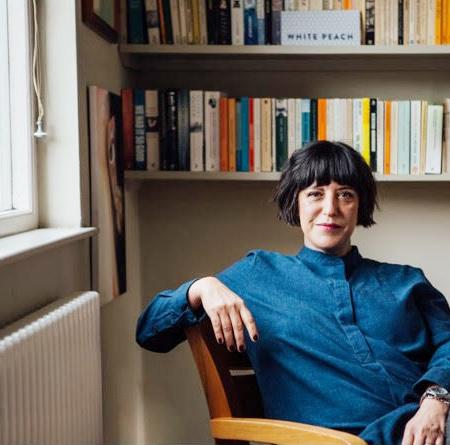
67 minute read
Auriel Majumdar
from SEEMA December 2020 Issue
by SEEMA
Celebrating Your Spirit
Creative coach, thinker and poet Auriel Majumdar discusses how to put heart back into working lives.
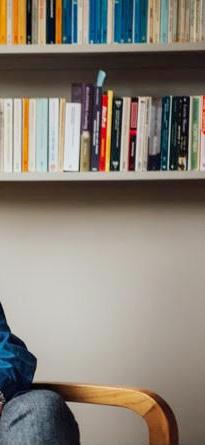
SEEMA KUMAR AND RADHIKA IYENGAR
Listening to Auriel Majumdar is like listening to a piece of music by Bach. Calm and contemplative, creative coach Majumdar’s technique invites you to reflect on your insecurities and examine them objectively. “It’s very easy to judge ourselves harshly,” she says. “Like, ‘I’m not trying hard enough’ or ‘I’m not working hard enough’, and that can trap us into staying in the same place.…Using reflective practice means sitting down and looking at what’s going on in your life and doing that without judgment.”
For the last two decades, creative coach, thinker and speaker, Auriel Majumdar has mentored individuals to lead rewarding, fulfilling lives. She has enabled them to tap their
inner potential and take control of their life’s narrative. Majumdar opens up about the personal experiences that have helped her become who she is, while also doling out extraordinary wisdom to younger career women who are grappling to find a work-life balance. Through creative personal development techniques, she encourages them to take the reins and pursue what they truly desire. Edited excerpts:
To begin with, could you talk a bit about where were you born? What was your experience growing up?
I was born in Winchester, which is in the south of England, I have no memory of it, because my dad was, at that point, a surgeon. So, in the UK health system, you build up your experience. You move around rapidly, getting different positions until you get to wherever it is that you want to get to. So, we moved a lot. We went up to the northeast of England, and then we ended up in Yorkshire when I was about four. So, my memories of growing up are from Yorkshire, which is in the north of
the UK. However, I was brought up in a town called Rotterdam.
I grew up in the mid-60s, through the 70s, and Rotterdam at the time, was a coal mining and a steel town. Highly industrial, but also quite depressed. Towards the 70s and the 80s, there was a real decline in industry in the UK, particularly in the north of England. I belonged to one of the very well off families, and was one of the very few Asian families. My mum was from Wales, she’s white, my dad was from Calcutta, India. We were a bit of an anomaly. We were highly unusual and highly visual.
It was around the 70s when there was a rise of a right-wing fascist group called the National Front. Those were tough times, really. There was a lot of racism—there were racist comedies on the telly (television). It was kind of acceptable to make racist jokes and people were called – I wouldn’t even say the word – but the P-word and the N-word were used. It was pretty tough being around all of that. There was a kind of pervasive threat around in the town. One of the memories of growing up was just being different and seeing myself different, while not really mixing with other Asian families, because there wasn’t really any community. It was quite isolating to be who we were.
At home, however, life was great. I’ve got three brothers, so it was always busy, full of life. I remember my dad being away, always working, because he was by that time a very senior orthopedic surgeon. So, he

wasn’t around much. However, my mom was around a lot. I also think that my parents tried to keep us safe by making us more ‘white’. My brothers, for example, have all got English names—Rob, Robin, Simon and Jeremy. I don’t know where Auriel came from. It’s not an English name. We also adopted very English habits. My mum was very young when she got married and had to live at my father’s family home in India. There she had learned how to cook fantastic curries and we grew up with that kind of food culture in our house. There were Indian things, but we weren’t brought up to speak Bengali. We weren’t really taught about our roots. So, there were family stories, but there weren’t stories about India or about Indian culture. I think my parents wanted us to be safe and not different. So, they tried to minimize the difference.
You talk about the far-right group and how racist comments were acceptable back in the day. While growing up, did you understand that this was wrong; that this is was a political thing and that it’s something needed to be done against it?
I’ve always had a very strong sense of injustice, of what is right and wrong. I remember being very young when something to do with apartheid came on the telly. And my mom said to me, “Well, if we went to South Africa, me and Jeremy would stand on one side of the fence, and you and Baba, Robin and Simon would have to stand on the other side of the fence.” I was tiny when she told me that and I remember thinking, “Well, this isn’t right.”
And I never lost that sense of wanting to fight injustice. I attended the Black Lives Matter protests and I do my best to be actively anti-racist. I’m constantly educating myself. In college, when I was 17-18, I was pretty politically active because my dad had been a communist in India, and his father had been highly politically active as well. So, it was somewhere in us.
Unfortunately, fascism is rising again and it reminds me of what it was like living in the 70s. In the UK, we’ve had Brexit, which has been an opportunity for divisive forces to come in and set people against each other. It’s kind of disappointing.

How did university life transform you into understanding yourself better?
At the university, I had this great kind of blossoming. I really enjoyed myself and wasn’t very obedient. I cut my hair – I’d had very long, beautiful hair and my dad wouldn’t let me cut it. Although he wasn’t traditional in lots of ways, he was the classic upper-middle class, intellectual kind of a person. He wasn’t an old-fashioned Indian, but because he’d come away from his Indian culture, he still had some very old-fashioned things about him. He wasn’t oppressive – he didn’t beat me at home or any of that – but there were things like hair, you know, that were really important to him. So, at home, I couldn’t cut my hair. Later on, my dad went absolutely mad; that moment was purely symbolic. You know, it’s like, I was just trying to break away.
So yes, university was great. I used to go to all sorts of lectures that weren’t on my curriculum–just exploring and trying different things, meeting new people. I was very, kind of, directionless—although, my career had already been set for me–I was expected to be a doctor. My mum had been a nurse and my dad didn’t really know what else there was out there. Although I was loving learning, I had no sense of what I was going to be, what kind of job I wanted, what my career would be, or what my what my path was really. It took me many years to find out what that was.
Your key messages to other women about making a career or a life pivot: One is don’t wait that long. But the the other is, it’s never too late. So, talk a little bit about that. I was always quite courageous. So, it wasn’t that I wasn’t brave enough, but I was very constrained by what
I thought was the right thing to do. I think those childhood habits of being obedient, made me suppress my own voice. I wasn’t really listening to myself. For me, it was like, “What’s the right thing to do?” At the time, I thought the right thing to do was work hard and look after my family. So, all those messages I’ve had in childhood, I kept with me for a long time.
What that means is that I wasn’t listening to the things that were really speaking to me. If I’d listened to myself, there would be something in me that would say, “No, there’s more, there’s more to life than hard work and diligence”. I think there’s something rewarding about listening to yourself, but also finding spaces where you can reflect. I am a highly reflective practitioner now. I spend a lot of time sitting with my own stuff and thinking about learning from it.
Reflective practice means you use your own material to decide what the learning is and what you want to do with that. It’s sitting down and looking at what’s going on in your life and doing that without judgment. We have to have a compassionate and neutral stance to our own experience, which might sound a bit mystical, but what I mean, is that it’s very easy to judge ourselves harshly. Like, “I’m not trying hard enough” or “I’m not working hard enough”. And that can trap us into staying in the same place, which might not suit us.
Why is reflective practice important and how do we exercise it?
Developing that reflective practice, even if it’s for five minutes at the end of the day, is important. Reflect on how your day went: What was good for you, what wasn’t so good? What would you like to change? What did you learn that you’d want to take forward from this experience? These reflections don’t have to be neurotic and dark, but you can constantly check in with yourself by asking: “How was that? How are things going for me? Is this bringing me joy?”
I also think, stop comparing yourself. It was a huge gift to me when I stopped seeing myself through other people’s eyes. You know, what are they thinking of me? And I actually started just thinking: Does this work for me? Does it suit me? Do I feel purposeful in this? So, judging my actions against my own intentions, rather than aligning myself to these ideas of success or growth was very important.

That’s very beautifully said, because through these reflective practices it’s almost like you’re coaching yourself. But how do you avoid the voices that come from others?
I think you have to develop a filter, like you would develop a muscle. The reflective practice becomes a muscle that builds and strengthens. For example, I was very sensitive as a young person. If somebody said something to me, it would cut right through me. And, I had no filter at all. I just assumed that anything that anybody was giving me was true, or whatever I was hearing in my own head was true. But with time, you can learn how to treat these things more neutrally and say, “Okay, so that person doesn’t like me, or they’ve criticized this piece of work. Now, what do I make of it? Do I want to own some of that and improve myself, or do I reject it?” By doing that, you can be more thoughtful about how you want to react to something.
I did a mindfulness course a few years ago and the guy who was running it was a Buddhist. He told me about the two arrows. The first arrow is the hurt that comes to you— somebody who has said something critical about you. The second arrow is the way you use that on yourself. You have the power to deflect the second arrow. I found that really
helpful. I think, it’s important to be the author of your own life. To me, that’s hugely creative. That’s why I think coaching is creative, because in my mind, coaching is making a space where people can decide on their own authorship, they can decide how they want their lives to be, the choices they want to make, the things they want to listen to and take into account.
How did your journey into as a coach begin?
When I came into coaching maybe about 10 years ago, I came to it through my own personal experience. I was coached as part of a leadership program, and had entered it quite reluctantly, because there was a perception (even just 10 years ago) that it was somehow “remedial” or for people who were “underperforming”. So, I was a bit reluctant. However, I ended up having such a positive experience. For me, it didn’t feel in the slightest remedial. I worked with a super talented coach, whom subsequently I now associate with. I do some work for her company and she does work with me and she worked in a very collaborative, empowering way. I was very fortunate really to have a role model and to be able to see how coaching could work. She would not try to force me down one path or the other.
Today, I work in a part of the coaching landscape where it’s about helping people to consider their options and to think about things like identity. I work within an approach called Gestalt which comes out of psychology and it’s a very subtle and beautiful practice. In a nutshell, it’s about raising awareness. The whole aim of coaching (of a Gestalt framework) is to raise people’s awareness and to help them take different perspectives. The theory being that you’ve got increased choice. So, if you can see more of the landscape or more of the bigger picture and take a different view on it, then you can change your mindset or make different choices.
I work in organizations, I work with teams, I do coaching and supervision, so I really like coaching education. I teach, I used to run. In fact, the Masters I ended up doing if you fast forward a few years, I ended up being the course leader. So, I had a couple years working in the university. And now I teach as a visitor, which I absolutely adore. That whole kind of cluster of helping other people have the journey that I had is super fulfilling.

Could you give an example of someone that you have coached who perhaps just had a similar sort of revelation?
Often organizations will bring me in to work with high flyers or people who are not quite fulfilling their potential. For example, I’m working with a woman in a big charitable sector organization. She’s young, tough and very talented. She’s been given this huge program management responsibility and her boss was someone I’d worked with in the past.
He said, “We really want to support this young woman, because we think she’s a superstar within, she’s going to do an amazing job. She’s just seems to get very stressed. Can you have a talk to her?” We arranged to have four sessions. We’ve had three of them and it’s interesting because what I’m doing is just holding reflective space for her. At the beginning, I asked her, “What do you think you’re going to get out of this?” And she said, “I can’t delegate”. She was all about perfectionism. She couldn’t delegate because nobody could do it to her standards. She couldn’t take her foot off the gas, because the standards would drop.
Also, she’s got no boundaries. She can’t say no to things. She can’t switch off from work at the end of the day, especially during Covid-19. She’s built this cage for herself in which her talent then is suffocated, because she’s so constrained by all these things and she’s exhausted. She’s got some limiting assumptions or limiting beliefs. The process involves her having to dismantle these beliefs, not me telling her. So, it’s not me saying, “Come on, don’t be daft. You don’t have to take all
this on yourself”. She has to do it on her own. This process involved doing little experiments. After each session, she’d commit. I’d say, “Let’s try these things, you know, try delegating. If you don’t like it, you can always go back to how you were.” Then she comes back and we look at the data and she decides what she wants to do. So, rather than she being at the mercy of all these beliefs and ideas she’s got about herself, she’s actually now in the driver’s seat. She can think, “Okay, do I want to be like that? Is this how I want it to be, or should I reshape it?” So, this is where the creativity comes in, because she can be the author of our own life. It’s very empowering in that sense.
Now, she’s starting to see the untruth of some of the things that she was assuming were true, and because she’s a super smart woman, she can do that logically with someone patient alongside her. And what happens is, you see the penny drop. So, it all comes from the work she’s doing herself. It’s interesting because women really believe in this whole idea of often have a hard time asking, self-authorship, where you start to especially male bosses or even be in charge of your own destiny.
female bosses, for a raise or for time off. They feel somehow that You talked a bit about resilience, they’re letting people down. And especially during times like Covin this particular example, I think id-19. How do you coach people that it’s similar where they’re not about resilience? I’m thinking delegating, because if the quality about Sheryl Sandberg and Adam of the product is not good, the boss Grant, who wrote the book called is going to hold them accountable, ‘Option B’.
and therefore they can never let go. It’s called ‘Option B’ where you can
Absolutely. There’s a particular actually choose a different option, theory that talks about drivers. rather than the option that you are We develop internal voices that we focused on. How can we be resildeveloped from childhood or from ient, not just during Covid-19, but educators who’ve been around us or throughout life? During Covid times, primary caregivers, and some of the it has been especially difficult for drivers are things like, work harder people, because things have not been or be the best. And, I think, to have in control. someone like a coach or a mentor I think control is one of the major working alongside you and encour- issues. We’ve seen a spiraling unceraging you and supporting you, while tainty and anxiety in the UK, because you’re doing that can really help, be- people feel powerless. There’s a whole cause it can be very scary to do that heap of stuff out there to be worried on your own, especially early on in about. And I know that all of this is your career. And let’s face it, women easier said than done, but I’m thinkare under more scrutiny, black people ing about Stephen Covey who wrote, are under more scrutiny—so, there The 7 Habits of Highly Effective Peoare high standards expected. And I’m ple. It talks about circles of control and circles of concern. For me, there is a self-awareness and the self-authorship comes into it again. So, I need to take time out to reflect, or do a practice in the morning to just kind of look at what’s been going on and think about, “So, what’s in my circle of concern? What are all the things I’m worried about? Of those things, what can I influence or what can I control?” And the rest, you know, you just put on a watching brief. It’s also a lot about setting boundaries, really. Boundaries are really important for resilience, especially during Covid. So, for me, zoom and stuff are great, but they’re really intense and direct. You’re basically asking someone come into your room, and I think that it’s then that we have to be really thoughtful about physical boundaries. d

GIFTING | SEEMA GIFTING FOR A CAUSE: DESIGNER MASKS
A Bangalore-based entrepreneur’s ‘Let’s Mask India’ campaign has touched thousands of lives while showcasing some of India’s dying embroidery traditions ANITA RAO KASHI

As the pandemic swept through India and the country went into lockdown, businesses shuttered and almost everything came to a standstill. But as livelihoods went into freefall, stories of incredible resilience and humanitarianism emerged; one of them even led to the evolution of Diwali special gifts.
Bangalore-based entrepreneur Deepa Chikarmane heads Pretinterpret Clothing Private Limited which has been around for over 20 years, exporting garments. She specializes in embellishing garments with hand-embroidery for top designers in North America. At the heart of her operations are karigar (craftspersons) from all over the country, especially home-grown ancient traditions handed down through the generations.
“But with the lockdown everything came to a standstill. However, quite apart from our own workers, there were plenty of garment factory workers everywhere who were unemployed and struggling to make a livelihood,” Chikarmane says. The team looked around for ideas and within 15-20 days decided to design a simple mask, not a designer face mask, one that anyone could make with a sewing machine at home.
Chikarmane, who employs about 70 people, opened up the factory for other garment workers as well, and people could work but with social distancing and masks. She also gave away extra machines they had so people can work from home. “We gave out fabric for tranches of 300 masks, which the workers could bring back the next day or whenever they could finish,” she says. The initiative gained momentum because everyone wanted work and it became a movement.
Impressed with her work, a philanthropist stepped in to distribute the high-quality masks to underprivileged people across the country who would otherwise not have access to them. “So we started a campaign called ‘Let’s mask India’ supported by sport stars such as Rahul Dravid, Sunil Joshi and Rohan Bopanna,” Chikarmane says. “But our other karigars, about 200-300 who are all over the country, also wanted to work,” she says. “So we thought we’ll talk about this powerful story, one that resonated with everyone, about people coming together and reinforcing faith in humanity.” The next step was designing pretty masks that also talked about the rich tradition of the country. “We decided to make a set of six masks with fabrics and embroidery traditions prevalent in different corners of India,” Chikarmane said. “We put it together and called it the Festival Edit, which makes for ideal special gifts. So there are masks that showcase kasuti (North Karnataka), kantha (West Bengal), Kutch and Kashmiri embroidery... Pretty much from the four corners of the country. We want people to buy into this idea.”
Woven distinctive woven fabrics from Assam to Kancheepuram were also used to lend uniqueness to the designer face masks. Proceeds from the sales go to support the karigars and workers. So far more than two million masks have come out of this movement and the project has touched the lives of about 5,000 people.
With the pandemic showing no signs of abating, and with masks now an unequivocal requirement for safety, stories like Chikarmane’s are incredibly touching. The heartening thing is that anyone, anywhere can buy into it and support a cause as well as use them as special gifts. d


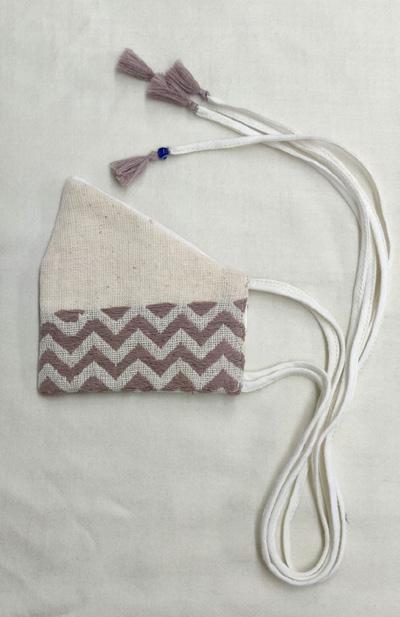




















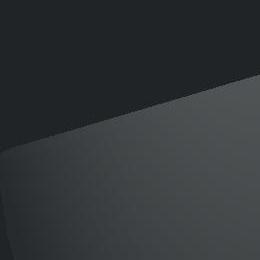




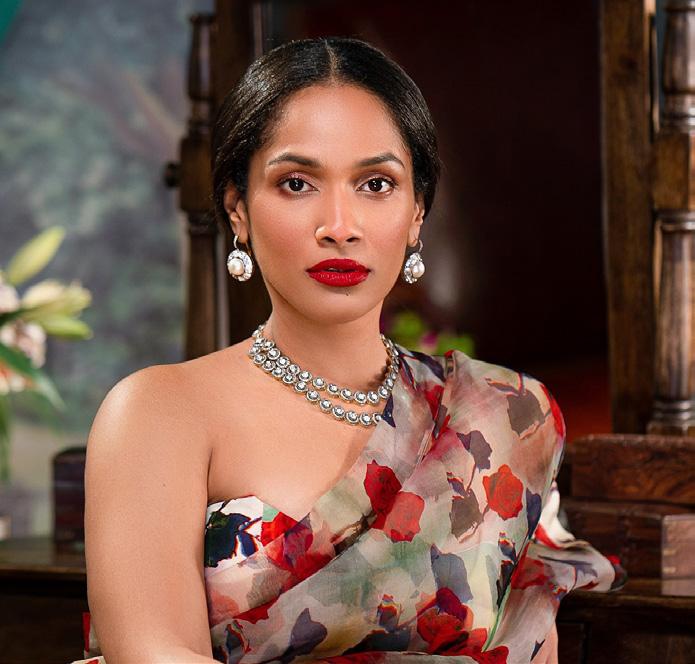
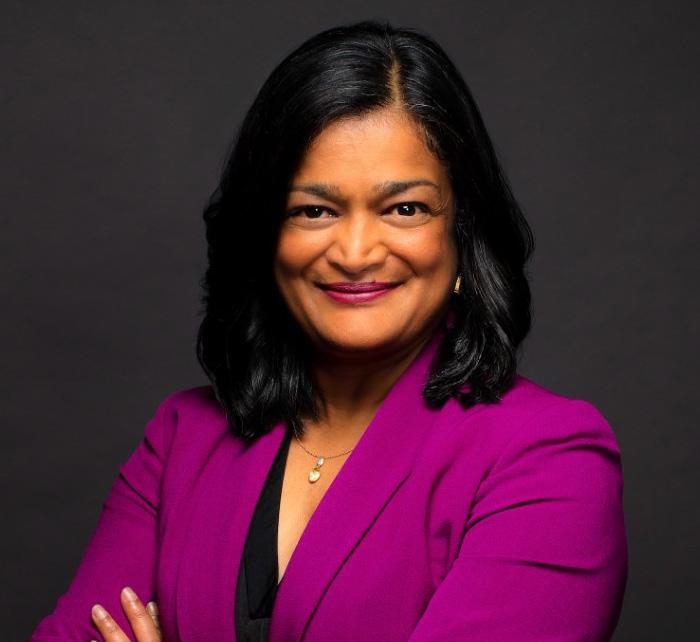
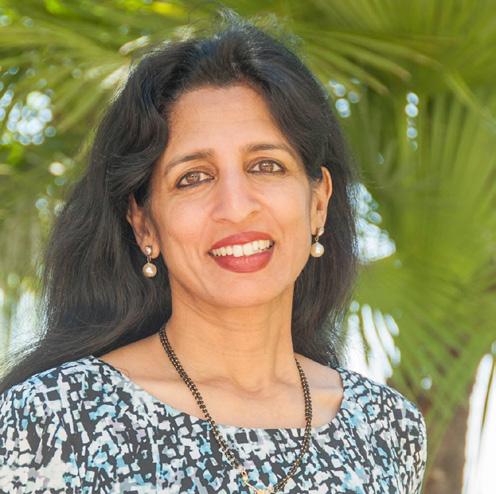



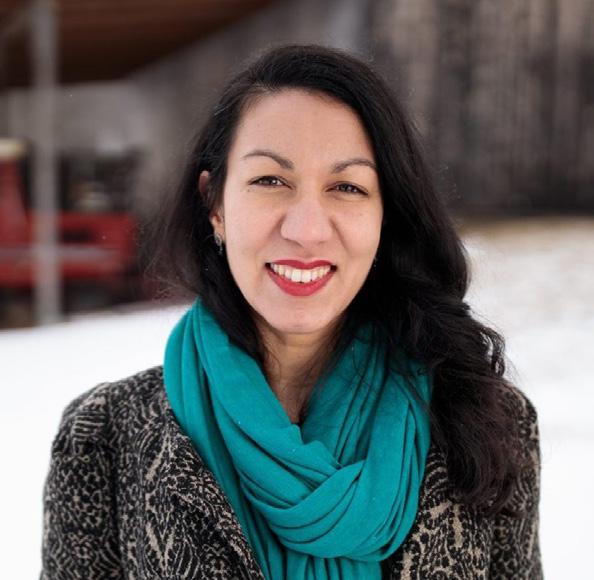

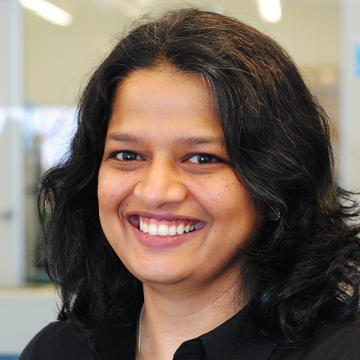





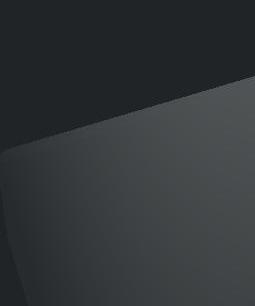


2020 2020 NEWSMAKERS:
HIGHLIGHTING WOMEN WHO MADE A DIFFERENCE IN THE YEAR GONE BY AND RAISE HOPE FOR THE FUTURE
2020 has been an unprecedented year. As it draws to a close, the COVID-19 pandemic is still raging, with a second surge threatening to create more havoc than the first on people’s health and the economy. However, with a vaccine on the horizon, the New Year is expected to bring hope and some relief. The past nine months have been challenging, but people the world over have stepped up to help communities and the most vulnerable. There are health care workers, scientists, firefighters, grocery store employees, aid workers, vaccine trial participants, and ordinary citizens all caring for their neighbors.
BHARGAVI KULKARNI
SPORTS 2020 2020 NEWSMAKERS
Sonia Raman became the first Indian American woman to be appointed assistant coach to an NBA team – the Memphis Grizzlies – and Seema Rao became India’s first woman commando trainer.
BUSINESS
2020 2020 NEWSMAKERS
Women like Jayshree Ullal, CEO of Arista Networks, and Neerja Sethi, vice president of Syntel, were among the 10 wealthiest Indian American billionaires in 2020, according to Forbes Magazine. Kiran Mazumdar-Shaw, executive chairperson of Biocon, was named EY World Entrepreneur of the Year 2020 for her contribution in improving universal access to affordable life-saving medicine and transforming the world.

Sonia Raman

Seema Rao Jayshree Ullal Neerja Sethi Kiran Mazumdar-Shaw

ENTERTAINMENT
2020 2020 NEWSMAKERS
As the world adapted to the “new” normal, streaming services became a prime source of entertainment, and ‘Netflix and binge’ took an entirely new meaning. Sima aunty (matchmaker Sima Taparia) and Aparna Shewakramani became household names, thanks to Netflix’s “Indian Matchmaking,” and fashion designer Masaba Gupta, star of Netflix’s “Masaba Masaba” became a hot topic in family WhatApp groups or weekly Zoom catch-ups with friends. The audience also got a taste of India’s hinterland – the crime, the locals, the crude language – via series like “Sacred Games” and “Mirzapur.” Among those behind the success of series like these, is Bela Bajaria, head of Netflix’s global shows. The 48-year-old is one of the highest-ranking Indian Americans in entertainment.

Masaba Gupta Bela Bajaria Sima Taparia
SCIENCE AND EDUCATION 2020 2020 NEWSMAKERS Women were in the forefront in education and science as well. Nineteen-year-old Anika Chebrolu of Frisco, Texas, was declared ‘America’s ‘Top Young Scientist’ after discovering a potential therapy for COVID-19. Dr Naseem Rangwala, a project scientist at the Stratospheric Observatory for Infrared Astronomy (SOFIA) at NASA, was part of the team that discovered water molecules in the Clavius Crater, one of the moon’s largest craters, and one visible from Earth. In education, Nergis Mavalvala, a Pakistani American astrophysicist was named dean of MIT’s School of Science; while Kavita Bala was named dean of computing and information science at Cornell University.


Anika Chebrolu Dr Naseem Rangwala Kavita Bala Nergis Mavalvala

US POLITICS
KAMALA DEVI HARRIS: BREAKING THE PROVERBIAL GLASS CEILING No Newsmakers list for 2020 will be complete without Vice President-elect Kamala Devi Harris, who, this August, became the first African American and first Indian American woman to be chosen as a presidential running mate. Her mother, Shyamala Gopalan Harris, came from Tamil Nadu in India; her father, Donald Harris, is a Black man from Jamaica. PRAMILA JAYAPAL: FIRST AND ONLY INDIAN AMERICAN WOMEN IN U.S. CONGRESS
This November, Pramila Jayapal (D-Wash.), comfortably won her third term in the U.S. Congress. A strong liberal and a member of the famous ‘squad,’ she made history in 2016 by becoming the first South Asian American woman to be elected to Congress.
KESHA RAM: A BROWN GIRL IN A VERY WHITE STATE Kesha Ram, 34, once again made history on Nov. 3 by becoming the first woman of color elected to the Vermont Senate in the state’s most hotly contested Chittenden District. Once a preschool teacher at the Burlington Children’s Space, Ram currently works as a consultant for towns, school districts, and organizations seeking to improve equity and inclusion in their organizations.
NIMA KULKARNI: DETERMINED TO MAKE A DIFFERENCE IN KENTUCKY Kentucky State Representative and Democrat, Nirupama ‘Nima’ Kulkarni is
“comfortable” serving her district, despite being “less optimistic and more determined,” after her party “took a beating” in the Kentucky State House. Her career experience includes working as the founder and managing attorney of Indus Law Firm, and at organizations like Louisville Public Media, the Community Foundation of Louisville, the Rotary Club of Louisville, and the Greater Louisville International Professionals.
NIKKI HALEY: FROM MADAME AMBASSADOR TO MADAME PRESIDENT? Nikki Haley, the former U.S. ambassador to the UN and former governor of South Carolina, is speculated to be a strong contender for Republican nominee for President in 2024 unless President Trump or Vice President Mike Pence step in. Gambling.com gives Haley an “implied probability” of 7.69% to win the White House in the 2024 presidential election. Haley created controversy during her address on the first day of the Republic National Convention on Aug. 24, where she defended President Donald Trump’s handling of the economy and foreign policy, and painted a picture of a dystopian America under Joe Biden’s and Kamala Harris’s leadership.
“Joe Biden and the Democrats are still blaming America first,” she said. “Donald Trump has always put America first. He has earned four more years as president.”
Haley, 48, was the only Indian American leader to be featured in the list of RNC speaker. This year, there was a buzz, although shortlived, that Trump would replace Pence with Haley as his running mate for the 2020 elections. Haley, however, quelled the rumors. During a tour last November to promote her book, “With All Due Respect: Defending America With Grit And Grace,” Haley told Fox News, “It’s amazing how this vice president stuff still keeps coming up.” Haley’s parents — Ajit Singh Randhawa and Raj Kaur Randhawa — emigrated to South Carolina from Punjab. They were the first Indian immigrants in the small town of Bamberg, South Carolina, about an hour south of Columbia. The New York Times reported that when Haley and her sister, Simran, entered the Little Miss Bamberg pageant, they were disqualified because the judges typically crowned one white and one black queen, and they didn’t know what to do with the Indian girls. She graduated from Clemson University with a degree in accounting and briefly worked in finances before entering government. She was elected to the South Carolina House of Representatives in 2004 and served as the state’s governor from 2011 to 2017, when she was appointed to her role in the Trump administration. After leaving her post as U.N. ambassador, Haley went on to serve on the board of directors of Boeing before she resigned from the lucrative position in March because of disagreements over airline bailouts amid the pandemic, according to National Public Radio (NPR). She has been working as the founder of Stand For America — an “issue advocacy group” promoting “freedom at home and strength abroad” — since leaving office.
To read more about women newsmakers in US politics, log on to www.seema.com
INTERNATIONAL POLITICS
NIRMALA SITHARAMAN: INDIA’S FIRST FULL-TIME FEMALE FINANCE MINISTER Nirmala Sitharaman was appointed as India’s first full-time woman finance minister in 2019. She holds two important portfolios — the finance ministry and the corporate affairs ministry — in the Narendra Modi-led Bharatiya Janata Party (BJP) government in its second term at the federal level. Always in the spotlight for her oratory skills and clarity of thought, Sitharam generated much media mention when she presented her first budget on July 5 with the longest budget speech in history.
PRIYANCA RADHAKRISHNAN: NEW ZEALAND’S FIRST INDIAN-ORIGIN MINISTER Last month, Priyanca Radhakrishnan created history by becoming the first Indian-Kiwi woman to become a minister in New Zealand. Radhakrishnan, 41, was one of five new ministers inducted into the cabinet of freshly reelected Labour Prime Minister Jacinda Ardern who also unveiled a revamped cabinet that she has described as “incredibly diverse.” Radhakrishnan is minister for the community and voluntary sector, minister for diversity, inclusion and ethnic communities, minister for
youth, and associate minister for social development and employment.
PRITI SUSHIL PATEL: BRITAIN’S CONTROVERSIAL POLITICIAN Priti Sushil Patel is a British politician serving as the country’s home secretary since 2019. An important member of Prime Minister Boris Johnson’s cabinet, Patel, 48, a member of the Conservative Party, is responsible for overseeing key issues such as immigration and law and order. She apparently impressed Johnson when she campaigned beside him for “Vote Leave” in the 2016 EU membership referendum. She has been in the headlines over allegations of ministerial misconduct and bullying in the workplace. She has voted against introducing same-sex marriage legislation and has expressed support for restoring the death penalty -- although she has since rowed back. In 2018 she was sacked from the cabinet for secret meetings with the Israeli government.
COVID-19 SHEROES
K. K. SHAILAJA: KERALA’S CORONAVIRUS SLAYER Popularly known as ‘Shailaja Teacher,’ K.K. Shailaja is the current minister of health and social welfare of Kerala, and the current MLA representing Kuthuparamba constituency. The 64-year-old has been involved with coronavirus rescue efforts since the beginning of the year, and is credited with flattening the COVID-19 curve in the state. When the World Health Organization (WHO) issued its first statement on the spread of a novel coronavirus in Wuhan, China, on Jan. 18, Shailaja began work to bring students from the state who were in the Chinese province. One of the first states to have a COVID positive case as early as January, Kerala is among the states that has high recovery rate, low death rate and slow progression, of COVID-19 cases in India. With effective management Shailaja contributed to bringing COVID-19 under control there.
SHILPASHREE A.S: BANGALORE’S STAR COVID-19 TESTER Since the coronavirus pandemic has been spreading in India, Shilpashree A.S. hasn’t been able to physically meet her children, or hug them. Despite this occupational hazard of being a COVID-19 tester, the Bangalore-based Shilpashree says there is no other job she would want to do. “Even though this involves risk, I love this job. It brings me happiness,” she says. Shilpashree was highlighted as one of seven unsung heroes of the pandemic in a blog post by Bill Gates. Every day, Shilpashree dons personal protective equipment, including a protective gown, goggles, latex gloves, and a mask, and then steps inside a tiny booth with two holes for her arms to reach through to perform nasal swab tests on long lines of patients. She has a critical job during this pandemic, but it comes with many hardships: the uncomfortable protection gear, long hours and isolation from family and kids. Also recognized in the Gates Notes is Laxmi Rayamajhi, a service provider in Sunaulo Parivar Nepal/Marie Stopes Nepal. Rayamajhi, a visiting service provider of the Long-Acting Reversible Contraception team from Kavre, hikes for hours over hazardous terrain, crossing rivers and landslides to reach villages where she spreads awareness about COVID-19 and other health concerns.
RANJANA DWIVEDI: GOING DOORTO-DOOR TO EDUCATE PEOPLE ABOUT CORONAVIRUS Ranjana Dwivedi from Madhya Pradesh’s Rewa district is the lone representative from India to be featured in NPR’s documentary of 19 women from across the globe who are overcoming challenges during the pandemic. Called Asha Didi in the village where she works, Dwivedi has served the hilly and remote Gurguda village in Jawa block of Rewa district, home to 500, for a decade now. What distinguishes Dwivedi from the rest of the volunteers is her use of paintings by her and her son to educate residents of the village about various government health programs, particularly involving COVID, immunizations and birth control. To accomplish that, Dwivedi has been traveling more than 15 miles daily from her home to Gurguda, a trip that involves crossing the mighty Tamas river in a boat.
“I twice fell in the river, but it has failed to jolt my duty and commitment to the villagers,” she told NPR. d

WORKING FROM HOME WOES Indian American Women Reflect on Life in Quarantine
BHARGAVI KULKARNI
It is an understatement to say that the coronavi- The Brookings Institute says that “COVID-19 is hard rus pandemic has upended the life we once knew. on women because the U.S. economy is hard on womSince March, the health hazard has abruptly en, and this virus excels at taking existing tensions and changed not just the way we work, but the way we ratcheting them up.” play, party and ponder as well. Video and FaceTime Of course, the disruptions to daycare centers, schools, calls are de rigueur, as social distancing mandates and after school programs have been hard on working have led to a more virtual existence, both personally and fathers, but a July 2020 Women In Academia report professionally. reveals that “working mothers have taken
Kids are at home, studying virtually, on more of the resulting childcare responwhile parents are juggling with their Despite the sibilities, and are more frequently reducing own work – and all the other stuff a life in quarantine has been throwing at challenges, their hours or leaving their jobs entirely in response.” them. From assisting kids in their vir- several women Despite the challenges, several women tual classes to fixing computer glitches; from being their play date to fixing have chosen to look have chosen to look at the positives: a slower pace of life, more family time, more time them a quick snack or a gourmet meal, parents have been performing at the positives: a to enjoy the outdoors, so on and so forth. Given the unprecedented times, SEEMA multiple roles for the last eight months slower pace of life, asked a cross-section of Indian American and counting. It is no surprise that the biggest burden more family time, women the ways they are coping with the new “normal.” Are they burned out, tired falls on women. Although the pandemic more time to enjoy and stressed? Or are they hopeful and has posed challenges to people of all ages, several studies suggest that women have the outdoors determined and thankful for a job, family and friends and roof under their head and been bearing the brunt of it. food to eat? Here’s what they had to say.
FALGUNI SHAH, GRAMMY-NOMINATED MUSICIAN
Since COVID-19 hit, musicians have lost a lot of work and I myself had 30 shows canceled this year. To survive the pandemic, I had to learn to create online shows and work virtually with other musicians. I started teaching online through my Carnegie Hall portal. I taught myself recording programs like Pro Tools and Logic Pro to keep recording and creating new musical content. I also made a nice room in my house to do live music virtually and painted my own walls to make it pretty so I learned some cool techniques on YouTube on how to paint a wall in your house and studio. I bought recording gear and created a home studio. One major setback is that as a band we cannot play in one room together. That is really heartbreaking. We have to now either do shows alone or with people who are local and can come over with a mask, keep social distancing in mind and then do some performances but music is such that a soul sings and a soul hears so without more souls in the room it is hard to sing for yourself. But I have learned to become my own audience.
ORKING FROM HOME OES

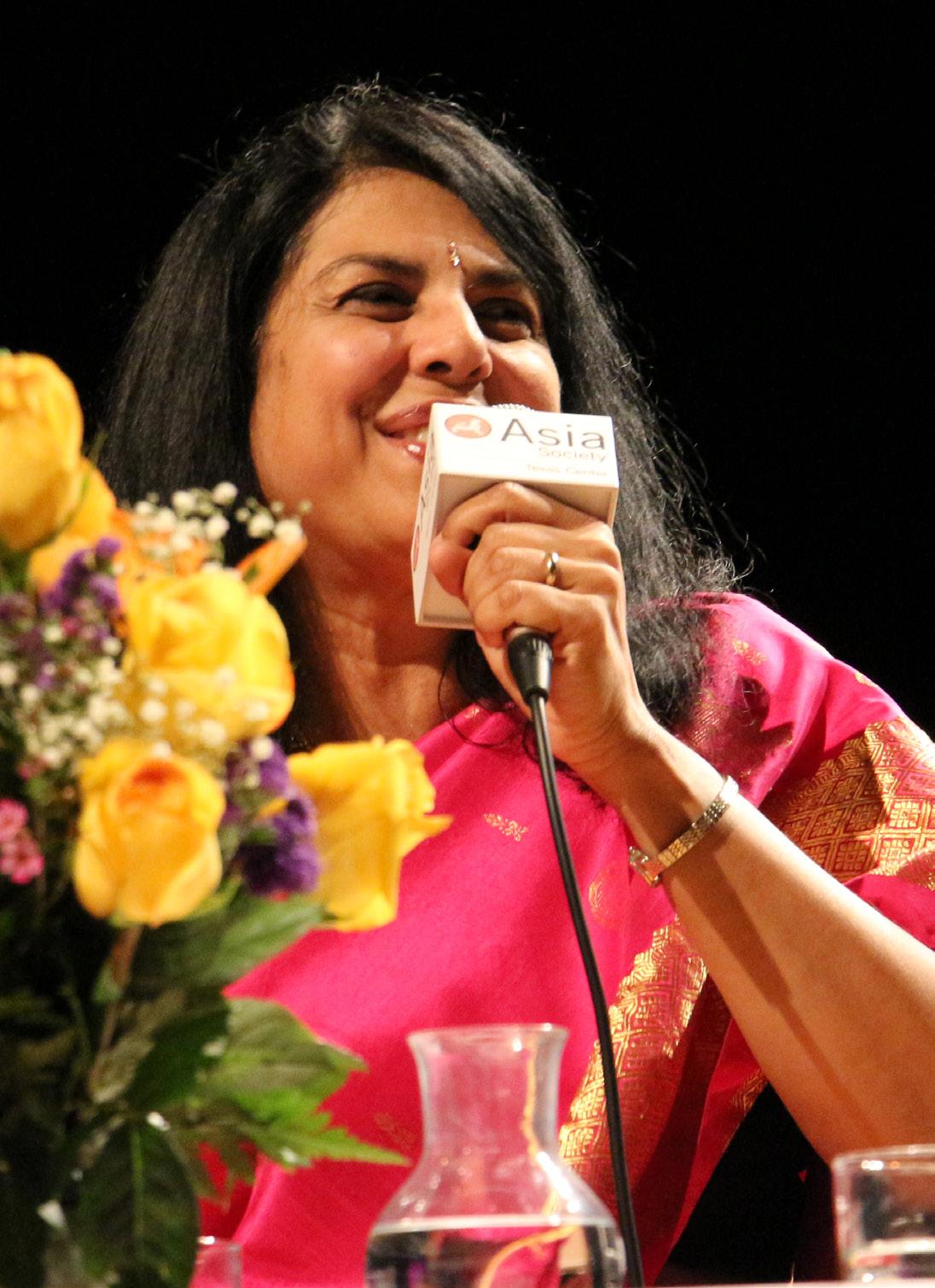
ORKING FROM HOME OES
CHITRA DIVAKARUNI, AUTHOR
As a professor, writer and speaker, my life has been impacted quite a bit by COVID. For one thing, I have had to move all my teaching online: lectures, exams and student conferences are all being conducted via Zoom and Microsoft Teams at the University of Houston, where I teach. This has been quite challenging as not all students are comfortable with online teaching. I, too, had never taught online before, so I had a steep learning curve. However, after several months, we have all become used to this new format.
As a writer, my work has not been impacted too much, except for research. I cannot get books as easily, or do in-person research in the library or on location. Most importantly, I cannot travel to India to do research as needed for my books. As a speaker, I often gave talks on my books at schools, universities and festivals, but with COVID, these have been cut down. I am doing some events over the internet, but the impact and the audience interaction is just not the same. However, overall I am very grateful that I am still able to work, and do it safely, because many people I know have been laid off or have been infected by COVID.
MANEET CHAUHAN, CHEF, ENTREPRENEUR AND TELEVISION PERSONALITY AND AUTHOR OF NEWLY-RELEASED COOKBOOK “CHAAT”
At our four restaurants, one of the most frustrating parts of the “new normal” has been how unexpected each and every day is. You can plan something in the morning and by evening, everything is completely different. But, there has been a lot of creativity, so we can come back stronger. You see the hospitality industry rallying together in an effort to make sure everyone’s entire team is taken care of. That is one of the cornerstones of the hospitality industry. It is all about nourishing — not only your stomach, but also your soul. On a personal note, since my usually crazy travel schedule has lessened, I’ve had extra time to get in touch with my husband Vivek’s and my families in India to gather authentic recipes that I am using to put together a cookbook to pass down to my children when they are older. I have been making recipes like my grandmother’s mango achar (an Indian mango pickle) and milk chicken (a chicken and potato dish with Indo-Chinese flavors), my mother-in-law’s almond sherbet and my aunt’s Indian fudge for my family each week. All these recipes are nostalgic and hold special memories for us, so I loved having the time to document them and prepare them for our kids.
ORKING FROM HOME OES

ORKING KESHA RAM, VERMONT STATE SENATOR FROM HOME Like many Americans, my focus is on those most affectOES ed by the pandemic and supporting their recovery and resilience. Both of my grandparents tested positive for COVID-19 and my grandmother was hospitalized five times due to COVID complications. We are approaching the holiday season, when some will feel the painful loss of a loved one who is no longer with us, or the sting of isolation from spending the holidays alone. Since March, my campaign has been focused on those being left behind in the pandemic recovery. Even in Vermont, a predominantly white state, Black and Brown Vermonters are deeply disproportionately affected in terms of COVID infection rates and economic impact. New Americans are struggling to access resources and information in their own language. When I take a seat in the state senate as the first woman of color in Vermont history, I will continue to do what I have done throughout the campaign and for much of my life – uplift the voices of the unheard.

SUJATA DAY, ACTOR, WRITER, ORKING FROM PRODUCER AND DIRECTOR HOME OES As a writer, nothing much has changed for me. I wrote a pilot script and my second feature film during the quarantine. Meetings and pitches have moved to Zoom and I prefer it to getting ready, driving to an office, finding parking, and sitting in the waiting area. As an actor, the “new” normal is weird. I’ve been in Zoom producer casting sessions where all the producers have their videos off, with sound muted and you are expected to give your best performance. Voiceover auditions are busier than ever. The industry has pivoted to what is safest to produce now and animation production is booming. Of the few productions hooting, most are getting shut down due to COVID-positive tests among the cast and crew. As a filmmaker, I premiered my first feature film, “Definition Please,” on the virtual film festival circuit. I miss the excitement of traveling to film festivals and watching my film on the big screen with an audience. Our team has adapted by participating in a lot of virtual panels and podcasts. I’ve taken this time to watch films and TV shows that always come up in meetings and conversations, that I’d never seen before. I am lucky because watching movies and TV qualifies as research for “work.” I write when I’m inspired and feel driven to write. I still make my pot of chai in the morning and drink it throughout the day, as I’m writing, watching and reading. I have more time to read books through the public library’s Libby app. I take long hikes around my hilly block, which I never did before. I make sure to get enough sleep and I am eating better, doing a lot more cooking at home. All of these habits allow my work productivity to flourish. In the meantime, I am fleshing out a couple pitches and outlines for my next scripts, prepping for post-COVID when all the projects can go straight into production.

SARINA JAIN, FOUNDER, MASALA BHANGRA WORKOUT
Being in the fitness industry for nearly 30 years and celebrating 20 years of Masala Bhangra this year, I can tell you that I have never seen this level of change before in my entrepreneurial life. I have had to adapt to this new norm by bringing all of our fitness classes virtually.
We offer classes virtually via video conference (i.e., Zoom) and social media. These classes have been better than I expected and very well attended. I have instructors from around the world teaching virtually. Also, we now offer Masala Bhangra Virtual Gym, where our students take more than one class with us. Because of this pandemic, I will say that it forced me to work quickly to get my instructor training done to offer it virtually. This was probably the best thing that happened. I can now train virtually anyone who wants to learn how to teach Masala Bhangra. It’s been a fantastic experience, and I am learning to become an expert in this new way of life.
Also, being in the fitness world, I have adapted to intermittent fasting, which I have been following since March of this year. I cannot exercise as much as I used to, so I have had to change my diet to maintain a healthy lifestyle. Staying fit allows me to motivate my students best and act as a positive role model. Offering virtual Masala Bhangra classes has helped many people stay mentally healthy and has helped students from outside of NYC attend classes. I also had the opportunity to grow Masala Bhangra with a new, dynamic community of people. Doing virtual classes together has kept us connected and in a youthful mindset.
With all the horrific things happening globally, I believe Masala Bhangra offers a pathway to health, a dose of fun, and unity.
ORKING FROM HOME OES
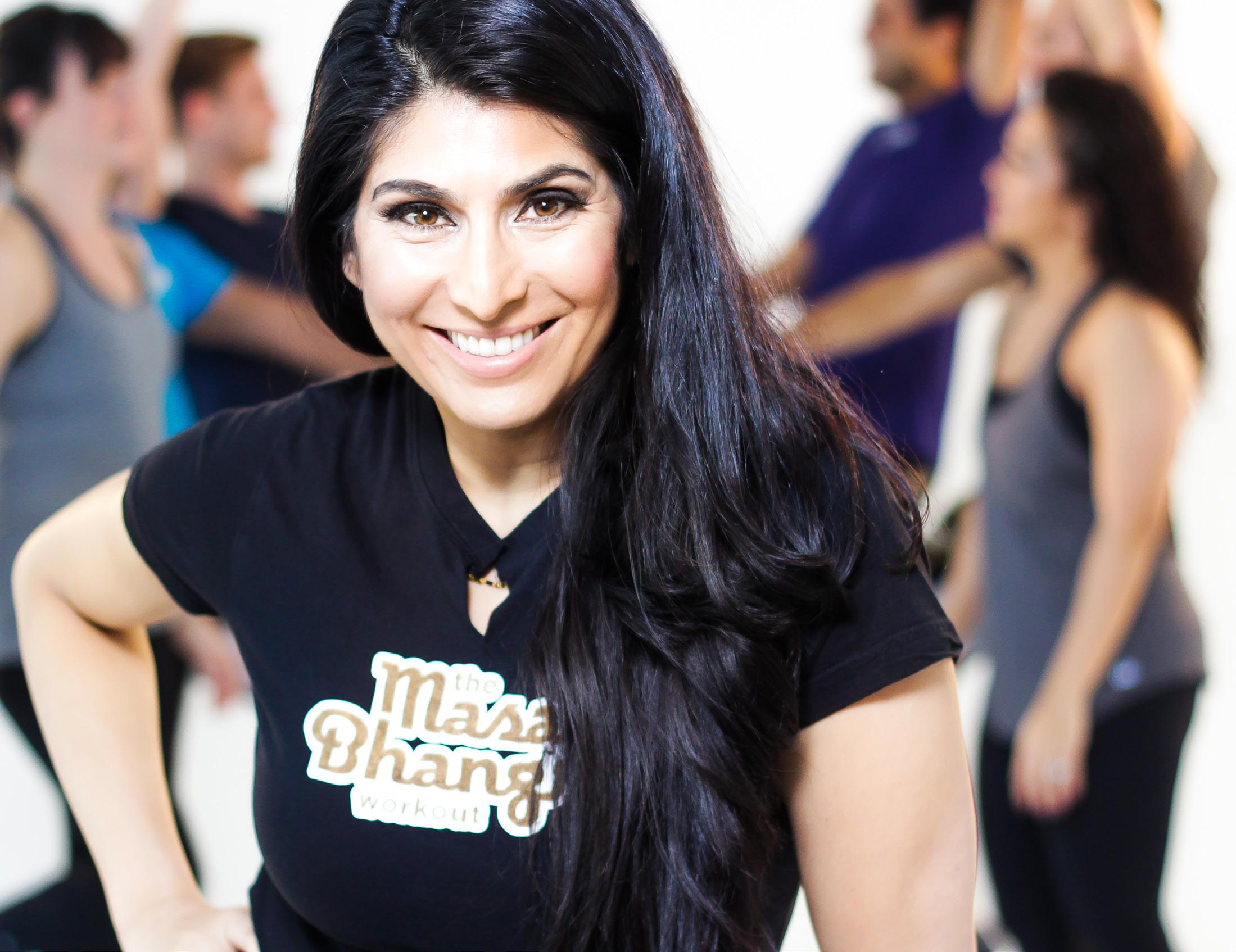
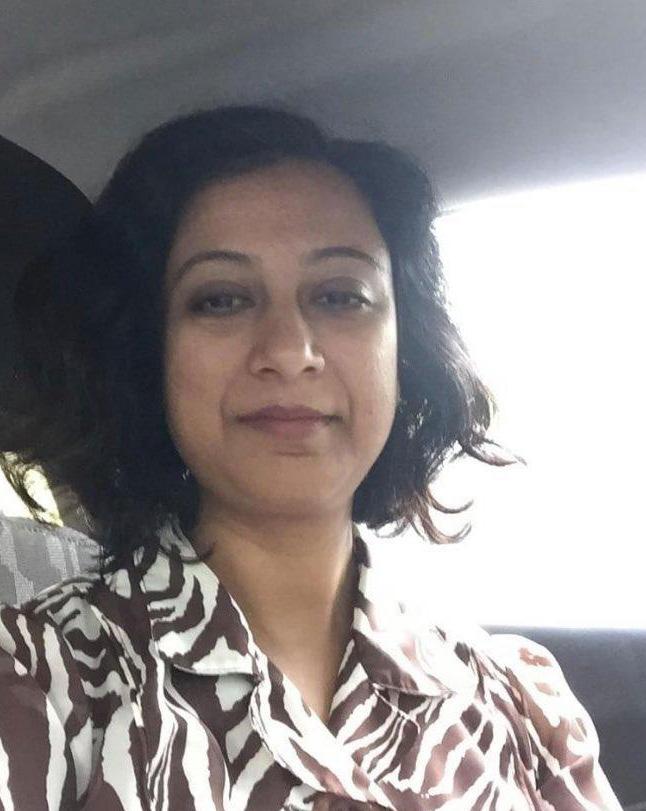
ORKING FROM HOME OES
ADITI PAL KARANDIKAR, MARKETING LEADER AT A TECH STARTUP IN SILICON VALLEY
First off, I am grateful to still have a job while many have lost theirs. Also, I must acknowledge my privilege in being able to work from home as a marketing leader with a hi-tech startup in Silicon Valley. Even in the IT sector and although I work with geographically distributed teams, there have been many layoffs so job insecurity combined with lack of FaceTime has led to much uncertainty. Gradually realization has dawned that deadlines and deliverables are what matter and people have learned to relax and trust their colleagues.
Gym breaks at lunch being a thing of the past. We fit in a brisk walk around our respective meetings schedules. I have set up a standing desk (at the kitchen counter guarding the junk in the fridge from the teen) as well as a bike work station for rainy days. Trying to eat healthy is still a struggle. As an Indian woman the brunt of the housework does also fall on me. Like, making sure meals are ready in a timely fashion, when the kid has lunch break or between meetings.
ANU GHOSH, SPECIAL EDUCATION
ELEMENTARY TEACHER ORKING FROM I had thought our virtual life would last three months at best. Nine months later, the novelty has worn off and the frustration HOME OES has set in. As a special education teacher, every morning as I greet my class of five sweet boys. I see their frustration. It is palpable. The tantrums are starting. Cameras are being turned off and kids are walking away, letting me know their day is done.
Their parents, who are stretched thin between juggling careers and demanding children, cannot wait for the kids to return to school. They have picketed the Board of Education, taken to the streets, and hit social media hard. But as the numbers of the infected rise, schools remain shut and we remain virtual.
I am getting more dejected. I feel my ability to teach and support these children is waning. I, too, am frustrated. Living with daily headaches and eye strain is hard. I hate that I cannot hug these children, when some days I know that is all they need. Yet, the rising numbers scare me and I am glad we are all safe at home. Being torn like this makes me feel I am a horrible teacher. Yet somewhere in the recesses of my mind, I know this is the right thing to do. My own children are tired of the social isolation and the long hours on Zoom. They want to walk the school halls and hug their friends. They want to whisper and giggle, heads close together and eat lunch not virtually (as these creative kids have been doing), but sitting side by side in the cafeteria. I tell them as I tell my class and myself, “Be patient, this too shall pass.” And with Thankgiving almost upon us, let us be grateful for good health and friends and family…. even if they are virtual.
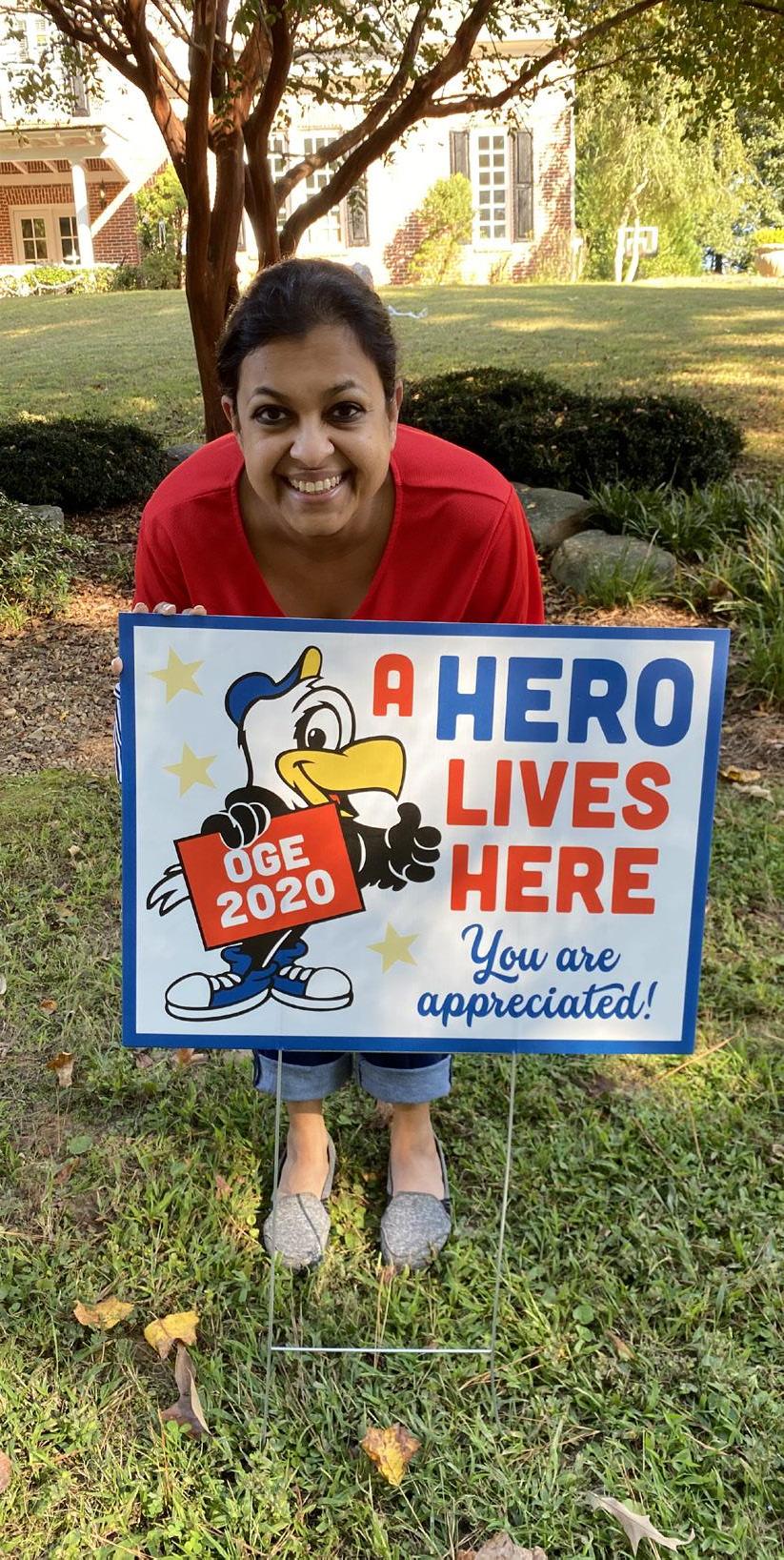
ZARNA GARG, STAND-UP COMEDIAN
I’m a stand-up comedian. A performer who needs an audience that I can look in the eye and connect with. Until March, I was walking a pretty established path, working the NYC comedy clubs, producing my own shows, applying for festivals. When COVID hit, I watched all my live shows get canceled one by one. My heart sank deeper and deeper with each email and phone call. I knew my audience still existed. They were just locked in their homes but they definitely needed a laugh more than ever. So I pivoted my strategy and I soon started booking online shows across the country, across time zones, and across the world. I found a connection in my online shows, booked by old and new fans in India, as each one brought friends, co-workers, and family closer, even though they were apart. When the New York City restrictions eased, I produced free outdoor comedy shows in Central Park, each with more than a hundred (masked and socially distanced) audience members. And now that the weather is getting cold again, I recently signed up
ORKING FROM HOME OES

with the number one online entertainment platform, Geniecast, a home for world-class virtual events. I am fortunate to still be working full-time. A lot of my comedian friends cannot say the same. But make no mistake, online comedy is even more demanding than club comedy. In a club, you walk into a room that’s buzzing with excitement and anticipation, where a single joke can blow the roof off the place! On Zoom, it’s much harder to cultivate that sense of shared experience. There are many lessons to be learned during this crisis and I am keeping an open heart and mind so I can receive them all.
ORKING FROM HOME OES

DIANA ROHINI LAVIGNE, CHIEF COMMUNICATIONS OFFICER AT A GOVERNMENT HEALTH DEPARTMENT AND A CALIFORNIA NATURALIST
Since my work revolves around residents’ health and wellness, changes to my work started in the first few weeks of 2020. The new normal was operating under a high-stress, fast-moving, high-stake environment while navigating the new normals in my home life, including distance learning for two kids under 10. The physical toll was significant, but the emotional toll was beyond my wildest imagination. I have made two significant changes in my work habits to support my success. Historically, I felt my communications team could not be highly productive unless in the office. I was wrong. To protect my staff, we decided to try working from home early on, and we found effective ways to work as a team remotely successfully. Secondly, I started to look at my work more as a marathon and less as a race. I began to prioritize time for self-care like eating right, getting a daily dose of nature, meditating, and sleeping enough. Prioritizing this has made me a better leader at work, a better mother and wife at home, and a better person to myself. As natural caretakers, I think most women leave their care for last. While I struggle to prioritize my selfcare on occasion, I am deeply committed to my self-care these days.
ORKING FROM HOME OES

SONIA BANOTA, REALTOR
My year started with a canceled contract days before the transaction was going to close, and I thought that was a bad omen. COVID came along just when the spring markets usually took off. But instead of the frantic listing we rely on, the real estate businenss was at its slowest in New Jersey. I was worried about whether I would achieve all the targets that I had set for my business this year. I used my lockdown stay-at-home days to catch up with my past clients and refresh old relationships.
But once the lockdown ended, we faced huge demand in the summer for suburban homes. Buyers wanted to move out of apartments in and around cities.
Interest rates kept dropping, fueling the demand. I was swamped. I had to be careful, keeping my family in mind. I had a COVID test result at hand at all times. I did virtual buyer consultations and virtual showings of homes using the latest technology tools available, like 3D tours.
I got more comfortable shooting video tours, too. In retrospect, 2020 turned out to be a better year than expected.
AYESHA HAKKI, FOUNDER, EVENTS BY AYESHA, AND PUBLISHER, BIBI MAGAZINE
Yes, 2020 has been life-changing, especially for an event planner and bridal magazine publisher like me. My businesses lost 80% of their revenue overnight. I panicked, and lay awake at night wondering how I would survive this.
On the positive side. I used the time to earn professional certificates, including one in contract law. I decluttered and organized my “stuff.”
I am reimagining and preparing my businesses for the future normal. More importantly, I am taking time for me: to paint, garden, read, nap, try new recipes, sit in the sun, relax, slow down. I have created more meaningful connections with friends, and I video-call my mother every day.
ORKING FROM HOME OES
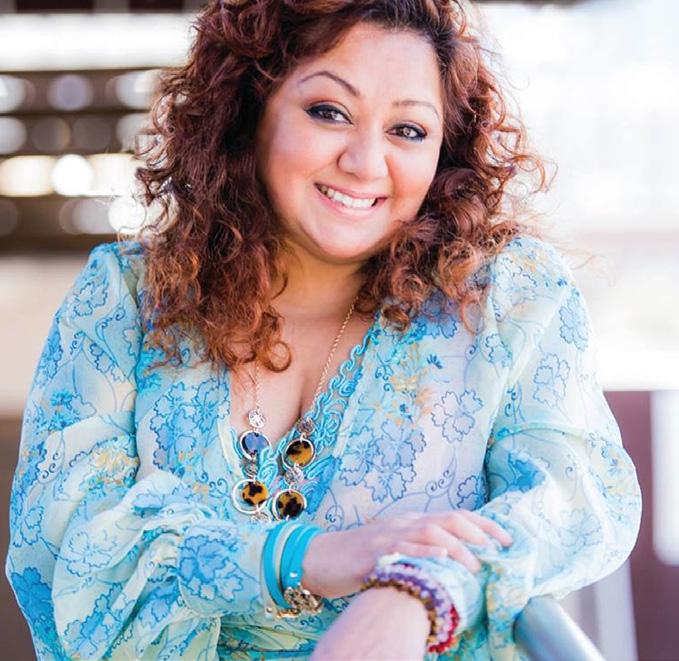
It is not always easy. I miss hosting dinner parties, planning a gorgeous wedding or cool party, I miss traveling and I miss social interaction. I hate wearing a mask, and I hate having to sanitize everything. In the end, I am trying to remain grateful and positive while waiting to emerge from this pandemic ready to get back to life, healthy (hopefully) and with a few new life lessons under my belt.
SADAF JAFFER, MAYOR, MONTGOMERY TOWNSHIP, NEW JERSEY

As mayor of my town, the COVID-19 crisis changed almost everything about my work.
I had to prioritize the best way to protect the community from the virus by participating in many virtual meetings And calls with elected officials and ORKING FROM administrators at all levels of government.
HOME I also helped devel-
OES op a crisis communications plan for the township to ensure that residents had the information they needed to stay safe and healthy. In my public presence, I tried to exude a sense of normalcy and consistency through live meetings and videos. As mayor, I continued to work on infrastructure projects like participating in a groundbreaking for Montgomery Township’s new library and municipal center.
Though it has been a tough year, women professionals have done an excellent job adapting to the needs of the hour. My thanks to all the women out there for their hard work!
NEHA MAHAJAN, RADIO JOCKEY, RADIO MIRCHI, US
Dolly Parton, the American singer-songwriter, said “If you want the rainbow, you gotta put up with the rain.” That’s how I see 2020, an opportunity in disguise.
Instead of lights, camera, action, a radio jockey’s life is more about entering the studio, checking the switchboard or the console and pushing the on-air button, something I did every morning leading up to March 23 2020. That was the first time ever I broadcast my show from home. Never before had I heard of an at-home radio station. It seemed impossible.
As a team, we explored how to recreate the same studio level quality from home, running multiple test-runs before finally succeeding. These past 8 months of working from home have felt like a fever dream. In-studio I’d be in my zone, talking my heart out, blasting music, and dancing to the tunes. At home, these things ORKING FROM HOME are just not possible. Blasting music and
OES talking my heart out would wake everyone up, and dancing would make me look crazy. What is worse is that the landscaper shows up every week for every adjoining house around our property to mow the lawn. The garbage truck crosses my street at the worst moments – when I am recording a piece and struggling against delay.
There are days when I have woken up the tech team and programming head at 5 a.m. because of a technical error, only to realize it was because the editing software was accidentally on mute. I’m LIVE on the show every day between 7 a.m. and 10 a.m., and record for five minutes before you hear me on air.
There have been times when a family member has walked in while I am recording a client interview or recording a caller interaction! Over time, they have adapted for me, and I for them. It’s just like they say, “the show must go on!” Mirchi Mornings has been going on every single day, no matter the obstacles it’s had to jump through.

INDIRA MAHAJAN, SOPRANO AND OPERA STAR ORKING FROM HOME OES Life as a musician in the age of this pandemic has been incredibly challenging.
Most performing artists have lost their income almost entirely. Broadway theaters, opera houses, and orchestras have been closed. Theaters cannot operate safely during this time. The number of people required to keep a production running can be in the thousands. This includes musicians, stage management, crews, the staff managing costumes, wigs and make-up, and the audience members. The number of people involved is just far too great to maintain or guarantee safety.
Even opening to a smaller capacity would not generate enough revenue to pay for itself. It has been a financially devastating time for people in the arts.
In the meantime, artists have come up with many ways to express their creativity.
This year, I participated in my first virtual recording. This is an opportunity for many artists to come together and record from their own homes using iPhones, Zoom, tripods, stacking boxes, or whatever elseo is available, to collaborate with other musicians to create recordings and videos.
Many artists have also started podcasts. Music lessons, including my own and my daughter’s, are now virtual. Ironically, musicians have been able to reach a wider audience this way. Many previously recorded productions have been streaming online, giving far more people access to the theater from the comfort and safety of their own homes.
The pandemic may have slowed down life in the creative arts, but it has not stopped it completely.

TANYA DEEPESH, CLINICAL PROJECT ASSOCIATE
I have adapted by making more FaceTime calls to my friends, spending more time with family, and pursuing hobbies that I did not focus on before. For example, I have been exercising more frequently by doing strength training, yoga, going on walks. I’ve also been able to create a platform for my interest in cooking and baking. I think all of this has definitely helped me cope with any COVID related stress. I work in the clinical research industry. Ever since I’ve been remote, I think my productivity level has been the same. I cannot really compare to how it would be in the office because I started my current job during the pandemic. However, I notice that I take less breaks and am not able to make the same connections I did with my previous co workers when we were at the office. My coworkers and I would usually go for lunch together and chat about our day but now I quickly throw some food together and eat it while I work. I have definitely tried to be more mindful of getting up in between tasks and getting some steps. I think the biggest change for me has been to check up on my coworkers by scheduling a few minutes every week to catch up instead of simply stopping by their cubicle.
ORKING FROM HOME OES


RAGINI JAIN, ACTRESS
As an actress in NYC, I was always on the go. Now my personal and work lives have drastically changed. Film sets have shut down for now, the production company I worked at also shut down temporarily. I lived near Elmhurst Hospital, in one of the worst-hit areas of NYC. Every five minutes I heard the sirens of ambulances bringning in new patients. It was scary and depressing. I moved to my parents’ home in upstate New York. After two weeks in quarantine, my life became very ORKING challenging. I was stuck at home with nowhere to go. FROM The exciting thing to do was going to the grocery with HOME OES my brother. Every other store was open only for a few hours - or closed. I have not seen my friends in person for eight months. The only events I go to are on Zoom, which at least help me stay on top of the entertainment life. Since my office is still closed, I work on creative projects from home.

RIMLI ROY, FOUNDER & ARTISTIC DIRECTOR, SURATI FOR PERFORMING ARTS

ORKING FROM HOME OES
Being the founder and artistic director of award-winning nonprofit Surati for Performing Arts, we have had to promptly adapt to a completely new system and approach. Since we produce large scale original staged shows and productions, concerts, events and programs, we have had to rethink all our programming ever since the lockdown started. We have produced some small-scale, socially distanced, in-person events with help from supporters, and also presented a series of online events. With online programming having a universal outreach we have changed our approach for good. We will be including an online component for all future events and shows so that we can reach out to a wider audience outside our area. The pandemic hugely impacted our classes, in-person concerts and events. With some funding support, we are continuing our programs virtually, but in a very limited way. It is a challenge conducting dance and music classes online - especially dance - when parents are looking for in-person interaction with their children, Because there is so much screen timeit is hard to push online programming. However, a huge plus with that is that we have been able to reach audiences not only in the U.S but also outside. I have had to rethink presenting and producing performing arts and cultural festivals in a different way. Rehearsal space has become a challenge, so I have restructured rehearsal space by converting some outdoor areas to workable spaces. However, ths is harder in winter. We are now working on a series of online concerts, documentaries, programs and educational projects. We are also working on some pre-recorded concert materials, In a way, it is probably going to be a good thing as we are adding a new medium to our work and exploring different ways of presenting. I have also been working on some online concerts, short / documentary films and music videos. I am in India now, so dancing outdoors will probably be easier, given the weather.


NIDHI KHANNA, CHAIR, ORKING FROM SOUTH ASIANS FOR BIDEN HOME OES COVID-19 has proved to be a challenge across the globe. Even for those of us fortunate enough to work from home, it can still be hard adjusting to months later. This year, I began working as a census manager for a community-based organization that received a grant to help direct census outreach in Staten Island (one of the five boroughs of New York City). The government uses census data to allocate proper funding and resources to communities across the nation. My team and I devised a comprehensive outreach strategy to make sure folks would complete their census questionnaire, but the pandemic halted all those efforts. As local officials were still deciding to implement mandatory stay-at-home orders in early March, I wanted to ensure that my staff in the field would be safe. Our team needed to find creative ways to conduct outreach for this important decadal count. We immediately shifted to an all-virtual operation and relied on digital tools such as social media, YouTube videos, and even peer-to-peer texting applications to educate members in the community about the census. My team members also created informative graphics, public service announcements, made thousands of calls in multiple languages, and organized virtual panel events with experts. Educating the community and encouraging people to complete their census was already difficult. Many people distrusted the government altogether and the misinformation about the census created hurdles. Nevertheless, we were still determined to exceed expectations. As COVID-19 restrictions were lifted in early summer, we started producing new informational materials in the form of fliers, pens, and buttons and circulated them to restaurants offering delivery services. Partnering with other comunity organizations was vital and allowed my team to provide informational materials during the public distribution of personal protective equipment or food. Despite the pandemic, our organizing efforts contributed to the highest census self-response rate in the city: 66.1%. It outperformed many major cities, including Los Angeles, Chicago, and Boston. The pandemic did make it harder for me to find a balance between work and my regular life – I needed to be available outside “traditional work hours” to support my team and coordinate efforts with other partners working on this project. Nevertheless, I believe this pandemic has changed the way people think about organizing in the issue advocacy or political world. The integration of digital tools in any outreach strategy is key, even after we return to the “new normal’’ and can continue to do in-person outreach safely. Many of these digital tools were available in the past, but everyone was not actively using them or strategically incorporating them to the overall goals of their organizing operations. This pandemic forced everyone at varying skill levels to leverage digital tools and to virtually meet people more frequently online. The online space can be used to serve the greater good. It is vital that we meet people where they need to effectively organize – now and in the future.
AMRUTA KULKARNI, FINANCE PROFESSIONAL, TRANSFORMATION AT WALMART ECOMMERCE
This pandemic has fortunately not been life changing. I have not lost anyone in the close family to the virus, my husband and I still have our jobs and can still work from home. However, life has indeed altered! I am now full-time working from home or living at work. I need to sync up my husband’s work calendar with mine as our 3-year-old needs help while she is distance-learning so we cannot have meetings at the same time. Being a full-time working mom of two, I used to get help with cleaning and meal prep, which I had to completely stop, thus putting a lot of additional work on my plate. We have resumed the cleaning ORKING FROM services and have re-allocated house-
HOME hold chores between
OES my husband and me, so there is some relief. But between the two of us we are still doing five full-time jobs. I am also worried about kids not being able to socialize with their friends and its long-term impact. The biggest drawback has been not being able to visit the parents in India. As taxing as it has been mentally and physically, there have been a lot of positives, too. I have been able to get back to dancing, learn new dishes, introduce kids to yoga (which has helped channel their energies), start biking again, eat a lot more home-cooked food, catch-up on reading, and, of course, bingewatch on Netflix. The biggest positive has been the veggie garden we created from scraps! So overall I think that I as an individual, and we as a family have adapted pretty well to the “new” normal though I cannot wait for this pandemic to be over.

PRADNYA HALDIPUR, VICE PRESIDENT OF DEVELOPMENT FOR CODE.ORG
Every call starts with, “Please let me apologize in advance for barking dogs and interrupting children!”
My plea for understanding either elicits a shrug, a laugh, or a knowing, “Oh, me too!!” These are strange days in any line of work. Any veneer of formality or a business-like tone is long gone. We are all feeling a disruption of work-life balance and the anxiety of living through a global pandemic.
I am a professional non-profit fundraiser. Success is borne out of building strong and authentic relationships with donors. Typically, this has been done through face-to-face meetings, coffee
ORKING FROM HOME OES

or lunch, attendance at special events, and other meaningful engagements with the organization. We have always assumed that “in-person” is the most effective. So, imagine my surprise when connecting with donors, prospective donors, and colleagues became easier through technology. Why? Perhaps because we have gained time in forgoing a commute. Maybe quarantine has made us more willing to engage beyond our four walls. Ultimately, I believe that shared vulnerability opens hearts and minds. When speaking to donors about our mission, I find that they are eager to look to a hopeful future. Being more “human” together (oh, those dogs and kids!) makes for a more relaxed conversation. This understanding is the silver lining I hope to take away with me even when we can sit across from each other, coffee in hand.
Look for more stories of women working from on SEEMA.COM
Celebrating the Season with the Bene Israel
Traditional sufganiyot are filled with fruit jam, but modern bakeries have been getting creative with both sweet and savory fillings

Latkes are made from shredded potato and sometimes onion, then deep-fried until golden brown and shatteringly crisp
This ancient Jewish group has lived in India for millennia, and has become part of the colorful cultural mosaic that makes modern India


JORDANA WEISS
India has been home to Jewish groups facing persecution for centuries. One of them is the Bene Israel, which boasts a legacy lasting more than 2,000 years.
Of course, India has been open to a variety of faiths. It is the home or birthplace of at least three major religions – Hinduism, Buddhism – and Sikhism and a refuge for many others.
Among those who came over were St. Thomas of Biblical fame, the Zoroastrians fleeing persecution in Iran, and the Bnei Menashe (one of the lost tribes
of Israel that found their home in northeast India). India still remains the largest religiously pluralistic and multi-ethnic democracy in the world. That is perhaps why a Jewish group like the Bene Israel could thrive there for centuries.
The Bene Israel are a small sect of Jews that have lived in India, primarily along the Konkan coast, for the last 2,100 years. The group’s history is murky, and has been shrouded by legend and myth in an attempt to explain how ancient Jewish traditions from the Middle East made their way to the western coast of India.
One story claims that the founders of the Bene Israel were seven men and seven women who survived a shipwreck, while others believe that their ancestors were one of the Ten Lost Tribes of Israel, who came to India after being persecuted by Assyrians.
Whatever their origin, the Bene Israel people have thrived in India over the last millennia. They adopted Indian surnames, which traditionally ended with ‘-kar’, and primarily worked as oil pressers – a job that served them well when they began to celebrate Hannukah.
INTRODUCING HANNUKAH
The majority of Jews around the world have always celebrated Hannukah. This holiday celebrates the rededication of the Second Temple in Jerusalem, after it was recaptured from Greek control by a group of Jewish warriors known as the Maccabees.
To reconsecrate the temple, a special lamp was lit, but there was only enough oil for one day. Miraculously, the oil lasted for eight days and nights, which inspired the eight-daylong celebration we know today.
Around the world, Jews celebrate this miracle by lighting a special can-
A traditional Indian hanukkiah, with space for oil lamps to fit in front of the Star of David

dle holder known as a menorah, or a hanukkiah, which has eight branches along with one taller branch, to hold the candle known as a shamash. The shamash is used to light eight separate candles, starting with one on the first day, and increasing to eight on the last day of the holiday. Jews also celebrate by eating oil-rich foods like latkes (fried potato pancakes) and sufganiyot (deep-fried jelly doughnuts).
One of the most unique aspects of the Bene Israel tradition is that they did not celebrate Hannukah before they made contact with other Jews. Some historians believe this is a sign that their arrival in India predates the destruction of the Second Temple. However, the holiday gradually caught on, and now the Bene Israel light oil lamps on Hannukah and share festive food with family and friends.
FESTIVE FOOD FOR HANNUKAH
Malida is one of the most beloved foods in the Bene Israel tradition. This sweet dish is made with pohe (flattened rice) that’s mixed with religious and culturally significant
Malida is a delicious sweet dish eaten by the Bene Israel of India which contains several Biblically significant fruit
ingredients like figs, pomegranate seeds, dates, nuts, and other fruit. Laced with jaggery, it tastes deliciously sweet.
While latkes remain popular in Israel and across the Jewish diaspora, Indian Jews like the Bene Israel prefer celebrating Hannukah with deepfried treats like onion pakoras, vada pav, or aloo makala. Aloo makala is particularly easy to whip up since it’s made from a large piece of potato, which is boiled then deep-fried in oil until golden brown and crisp.
Whether you celebrate with latkes or aloo makala, halwa or sufganiyot, there’s no wrong way to ring in the joyous season of Hannukah. d









